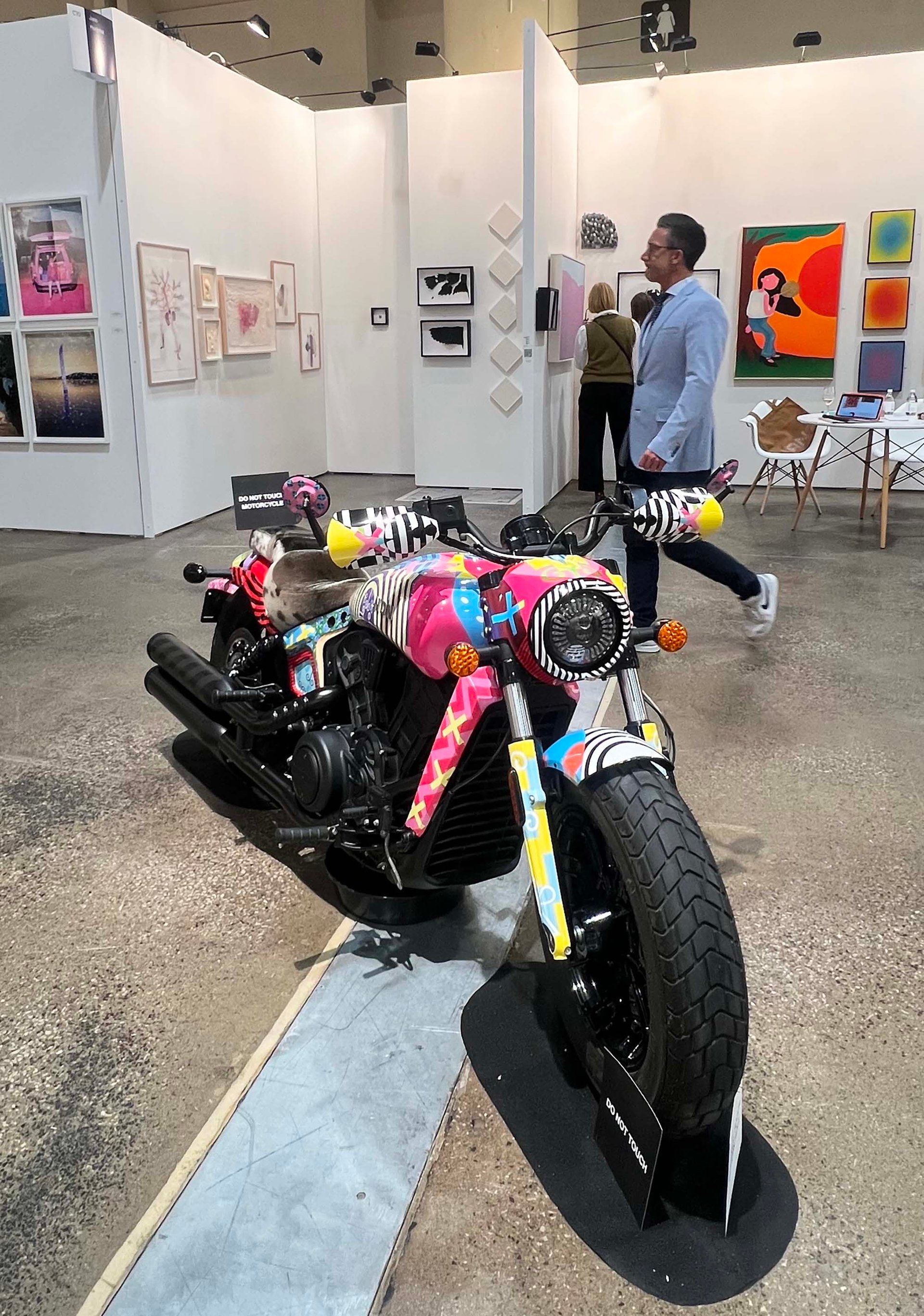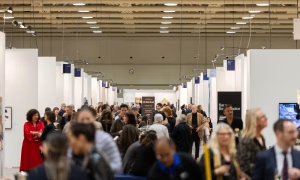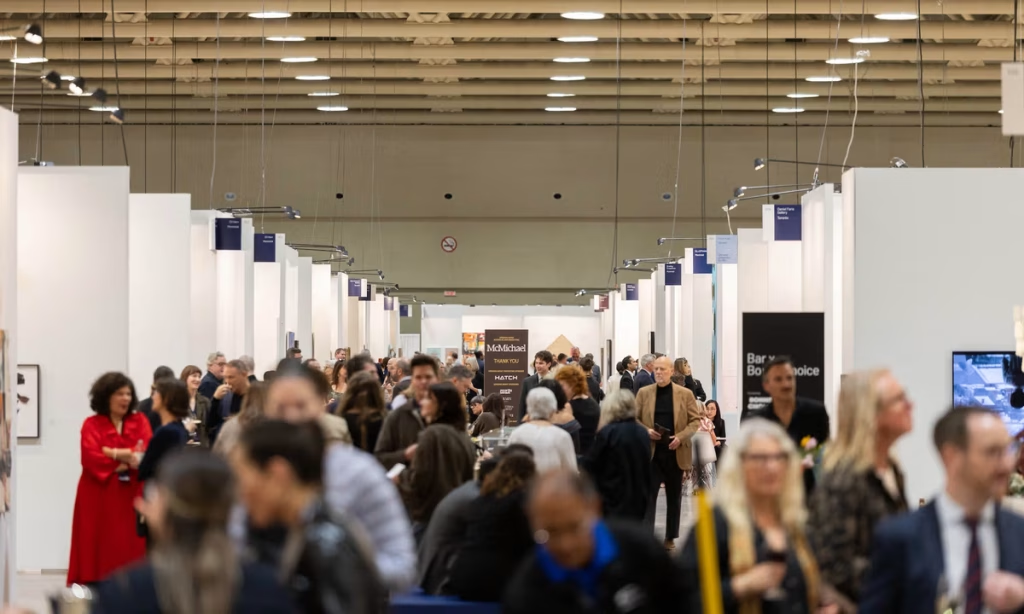What is Indigenous art today? Many viable answers await at this year’s edition of Art Toronto (until 26 October), where more than half of the 121 participating exhibitors feature works by Indigenous artists on their stands, mainly from Canada but also from Latin America and Australia. This curatorial throughline, achieved organically rather than mandated by the organisers, reflects growing interest from both collectors and institutions in Indigenous art. The stands at the Metro Toronto Convention Centre challenge stereotypes and expectations about Indigenous art, displaying a wide variety of media and expressions from oil paintings and beadwork to performances and mixed-media works where territory, multiculturalism, ritual, nature and identity intersect, while sparking art-historical conversations with Western art.
Indigenous artists figure prominently in Arte Sur, the fair’s new Latin American section curated by Mexico-based gallerist Karen Huber. Among them is Natalia Montoya (showing with the Chilean gallery Judas), an Aymara artist from the Andes who uses painting, performance, textiles and contemporary totems to explore her Afro-Indigenous identity while addressing pressing social issues. Also featured are the abstract works on paper by Sheroanawe Hakihiiwe, a Yanomami artist from the Venezuelan Amazon who is showing with the New York-based gallery Proxyco, which reported a sale of one of Hakihiiwe’s pieces early on during the fair.
Works by Natalia Montoya on the Judas Galería stand in Art Toronto’s new Arte Sur section Photo © Constanza Ontiveros Valdés
Most stands feature Indigenous art from Canada, with some galleries entirely dedicated to First Nations artists. Toronto’s Feheley Fine Arts, one of the first to champion Inuit art and a regular participant in the fair, embodies this legacy. “Early on, I had to convince people this was art; now there’s much more space for Inuit art,” says Patricia Feheley, the gallery’s director.
Others, like the Vancouver-based gallery Ceremonial Art, focus on West Coast Indigenous artists. “There’s a national movement of acknowledgment that spreads across the board,” says Jake Kimble, the gallery’s curatorial director.
In Generations, a new sector curated by the fair’s director Mia Nielsen and focused on drawing intergenerational connections between Canadian artists, the Vancouver-based Fazakas Gallery has focused on Indigenous artists, featuring established figures like Catherine Blackburn from Patuanak, Saskatchewan, alongside emerging artists like Zoe Ann Cardinal from Ponoka, Alberta. “The word ‘traditional’ sets us in a historic past; I honour the past, but we are contemporary people,” says Blackburn, who is showing works that blend beadwork, memory and her ties to family and territory.
“We want to show new perspectives on Indigenous artists,” says Wil Abale, the director of the namesake Vancouver gallery, which is showing works by Cheyenne Rain LeGrande, a member of the Bigstone Cree Nation, including a shawl made with ancestral techniques and soda and beer can tabs gathered by her community.
Some Indigenous artists featured at the fair take creative, critical approaches to art history and branding. On the Canadian gallery Patel Brown’s stand, the duo Native Art Department (formed by Maria Hupfield and Jason Lujan) is showing abstractions in the Woodland School style that reveal its essential components. The Halifax-based gallery Iota Studios is featuring the work of Mi’kmaq artist Jordan Bennett, who removed all stereotypical elements from an Indian Scout Bobber motorcycle, including headdresses, totem caricatures and the brand’s trademark “Indian”, replacing them with his own work and a sealskin seat.

Jordan Bennett’s LNUK Motorcycle (2025), presented by Iota Studios, at Art Toronto Photo © Constanza Ontiveros Valdés
Nadia Myre, a member of the Algonquin Kitigan Zibi Anishinabeg First Nation whose atmospheric landscapes are made of handmade ceramic beadwork, is featured on both Blouin Division’s group stand and Macaulay + Co’s solo booth. On the fair’s preview day (Thursday), Macauley + Co sold works by Myre to both RBC (the fair’s main sponsor) and the McMichael Canadian Art Collection (which just revealed initial details of an ambitious expansion and renovation). Myre is also unveiling a new commission at Toronto’s Gardiner Museum as part of ground-floor renovations that include the museum’s first Indigenous galleries.
The attention that Indigenous art is receiving in Canada is exactly what motivated the Sydney-based gallery N. Smith to participate in the fair. “We looked at the global scene where there’s a strong understanding of First Nation art and Canada celebrates it, so we wanted to bring our artists into that dialogue,” says Nicholas Smith, the gallery’s director. “To hear Indigenous representation at the fair is big, and showing alongside artists from around the world is empowering,” says Dylan Mooney, a Yuwi, Torres Strait and South Sea Islander artist showing digital paintings of native plants layered with ochre as a reference to the still life genre and land.
Art Toronto’s busy opening night benefiting the McMichael—which also acquired works by Joseph Tisiga (a member of the Kaska Dena Nation) and Haley Bassett (an artist of Red River Métis and settler descent) from the fair, among others—underscored the Canadian art scene’s prioritising of Indigenous support and representation.
At the fair and elsewhere during Toronto’s growing Art Week, it was also evident that gaps in representation remain. A Black Art Fair (25-26 October), an event organised by Toronto’s non-profit Nia Center for the Arts and now in its third edition, champions the work of Canadian Black artists. It is another example of earnest efforts underway within the established art industry and beyond to foster a more inclusive community.
- Art Toronto, until 26 October, Metro Toronto Convention Centre

